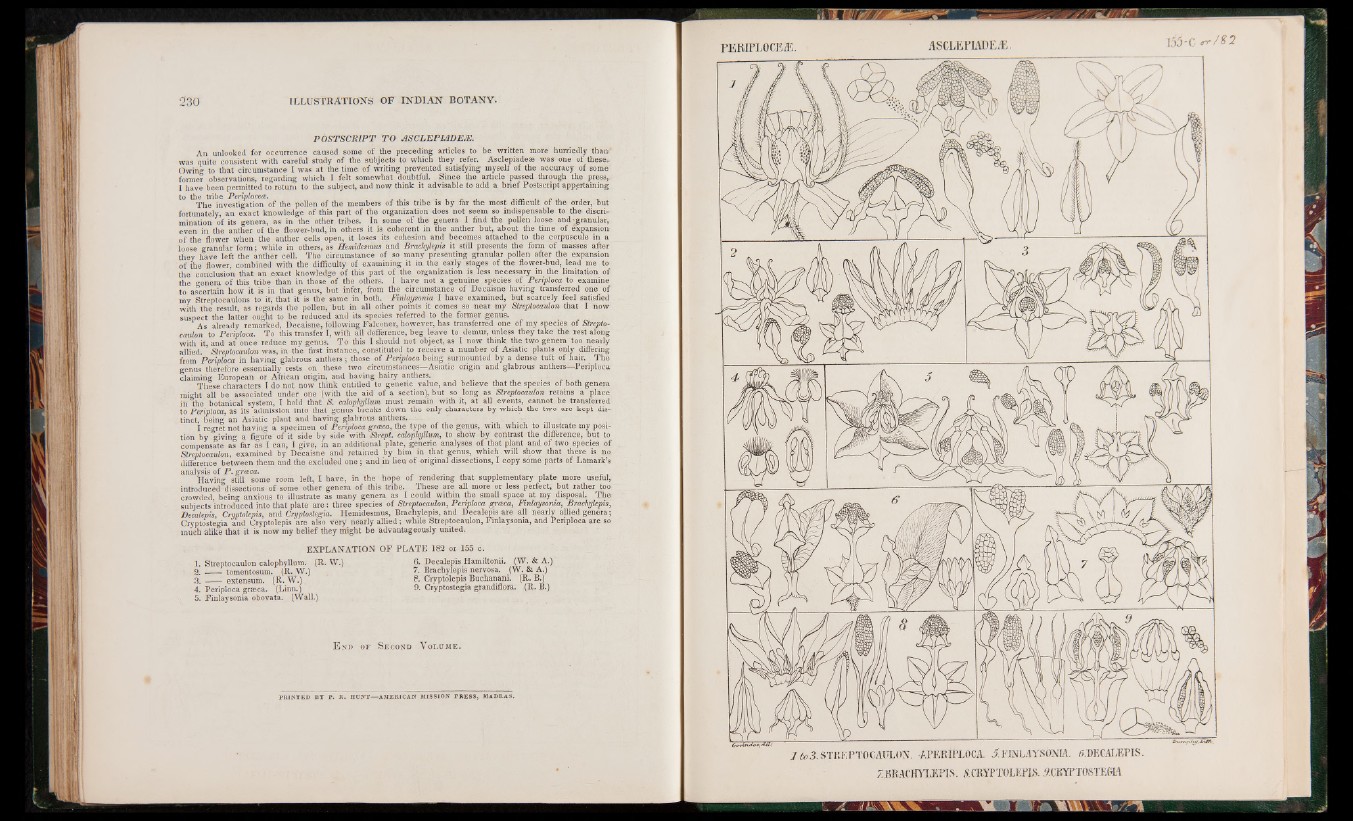
P O S T S C R I P T T O A S C L E P IA D E Æ .
An unlooked for occurrence caused some of the preceding articles to be written more hurriedly than*'
was quite consistent with careful study of the subjects to which they refer. Asclepiadeæ was one of theses
Owing to that circumstance I was at the time of writing prevented satisfying myself of the accuracy of some-
former observations, regarding which I felt somewhat doubtful. Since the article passed through the press,..
I have been permitted to return to the subject, and now think it advisable to add a brief Postscript appertaining
to the tribe Periploceoe. ,
The investigation of the pollen of the members of this tribe is by far the most difficult of the order, but
fortunately, an exact knowledge of this part of the organization does not seem so indispensable to the discrimination
of its genera, as in the other tribes. In some of the genera I find the pollen loose and ^granular,
even in the anther of the flower-bud, in others it is coherent in the anther but, about the time of expansion
of the flower when the anther cells open, it loses its cohesion and becomes attached to the corpuscule in a
loose granular form ; while in others, as Hemidesmus and Brachylepis it still presents the form of masses after
they have left the anther cell. The circumstance of so many presenting granular pollen after the expansion
of the flower, combined with the difficulty of examining it in the early stages of the flower-bud, lead me to
the conclusion that an exact knowledge of this part of the organization is less necessary in the limitation of
the genera of this tribe than in those of the others. I have not a genuine species of Periploca to examine
to ascertain how it is in that genus, but infer, from the circumstance of Decaisne having transferred one of
my Strep to caulons to it, that it is the same in both. F in la y so n ia I have examined, but scarcely feel satisfied
with the result, as regards the pollen, but in all other points it comes so near my Streptocaulon that I now
suspect the latter ought to be reduced and its species referred to the former genus.
As already remarked, Decaisne, following Falconer, however, has transferred one of my species of Streptocaulon
to Periploca. To this transfer I, with all defference, beg leave to demur, unless they take thé rest along
with it, and at once reduce my genus. To this I should not object, as I now think the two genera too nearly
allied. Streptocaulon was, in the first instance, constituted to receive a number of Asiatic plants only differing
from Periploca in having glabrous anthers; those of Periploca being surmounted by a dense tuft of hair. The
genus therefore essentially rests on these two circumstances—Asiatic origin and glabrous anthers—Periploca
claiming European or African origin, and having hairy anthers. .
These characters I do not now think entitled to generic value, and believe that the species of both genera
might all be associated under one (with the aid of a section), but so long as Streptocaulon retains a place
in the botanical system, I hold that & calophyllum must remain with it, at all events, cannot be transferred
to Periploca, as its admission into that genus breaks down the only characters by which the two are kept distinct,
being an Asiatic plant and having glabrous anthers.- |£
I regret not having a specimen of P eriploca groeca, the type of the genus, with which to illustrate my position
by'giving a figure of it side by side with Strept. calophyllum, to show by contrast the difference, but to
compensate as far as I can, I give, in an additional plate, generic analyses of that plant and of two species of
Streptocaulon, examined by Decaisne and retained by him in that genus, which.will show that there is no
difference between them and the excluded one ; and in lieu of original dissections, I copy some parts of Lamark’s
analysis of P . groeca. . §1 A , . . I . ,
Having still some room left, I have, in the hope of rendering that supplementary plate more useful,
introduced dissections of some other genera of this tribe. These are all more or less perfect, but rather too
crowded, being anxious to illustrate as many genera as I could within the small space at my disposal. T he
subiects introduced into that plate are : three species of Streptocaulon, Periploca groeca, F inlay sonia, Brachylepis,
Decalepis, Cnjptolepis, and Cryptostegia. Hemidesmus, Brachylepis, and Decalepis are all nearly allied genera ;
Cryptostegia and Çryptolepis are also very nearly allied; while Streptocaulon, Finlaysonia, and Periploca are so
much alike that it is now my belief they might be advantageously united,
EXPLANATION OF PLATE 182 or 155 c.
1. Streptocaulon calophyllum. (R. W.) 6. Decalepis Hamilton«. (W. & A.)
2. - — tomentosum. (R. W.) 7. Brachylepis nervosa. (W. & A.)
3 . ____ extensum. (R. W.) 8. Çryptolepis Buchanam. (R. B.)
4. Periploca græca. (Linn.) ' 9. Cryptostegia grandiflora. (R. B.)
5. Finlaysonia obovata. (Wall.)
E nd of S eco n d V o l u m e .
PRINTED BT V. R. HUNT— AMERICAN MISSION PRESS, MADRAS.
PEMI’LOCF.Æ. ASCLEPIADEÆ. I# -C n - f t î
7 ,BRACHYLEPIS. «ÇRYPTOLEPIS. Y.CEYPT0STECL1